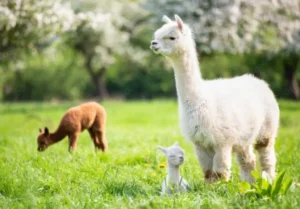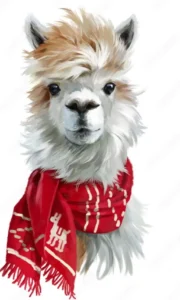
What is the strange looking creature that is popping up in small farmsteads across the country? It might just be alpacas! Take a good look. You’ll understand why alpaca’s carry the title of the world’s cutest camel! This smaller relative to the more familiar llama is easy to care for and joy to own—just ask one of the many alpaca owners and breeders.
Alpaca owners reap many rewards by choosing to raise these pleasant animals. Not the least of which is the welcome news that alpacas can be counted on for several great sources of farm income. Yes, alpaca’s can be revenue generators! We’ll take a good look at several ways to generate money with alpacas. If you have experience raising alpacas, be sure to share your personal stories with the rest of us. Leave your comment below in our comment section. We’d love to hear from you!
Alpacas are about half the size of their cousin the llama. They were first imported into the United States in 1984. This was not, however the first time alpacas made their home in North America. Many years ago, ancestors to the modern-day alpacas roamed freely on the plains of central and south-central United States. Over the years, some of these animals wandered across the land bridge between North America and Asia. Those early ancestors finally evolved into the modern-day Bactrim and Dromedary camels of Asia and Africa. Other ancestors headed south to the Andes mountains in South America where they became modern day alpacas, llamas, and vicunas.
 Two Varieties
Two VarietiesSouth American alpacas come in two varieties: Huacaya and Suri. The Huacaya get the nickname “teddy bear variety” owing to its fluffy fleece. When we think of alpacas, most of us picture the teddy bear kind. The Suri alpacas, though less popular, prove themselves valuable for luxurious straight fiber. Suri fiber is prized for its unique luster and superb soft, slick texture. It is used primarily for producing fine textiles and elegant knitwear requiring a soft, flowing, and drapey appearance. It is highly sought after by fashion houses because of its rarity, bringing a premium price in the fiber market.
In North America harvesting fiber and producing breeding stock dominate the uses for alpaca. Warm, soft, resilient, alpaca fiber converts easily to yarn. It can then be woven, knit, or crocheted into many styles and types of clothing, blankets, tapestries, and decorative items. An adult Alpaca can produce between four and nine pounds of fiber per year. Most beneficially, many alpacas can live to be 15 to 20 years of age. That translates into a lot of years of harvested fiber over an alpaca’s lifetime.
Many alpaca owners have found ways to make income well beyond merely harvesting raw fiber. Most of us know that a finished product is much more valuable than the raw materials that go into making the product. It only follows that items made from alpaca fleece command a strong price for the beauty and practicality of alpaca fiber. For even greater profits, many owners learn skills like spinning and weaving to get their fleece to that finished product efficiently and at the lowest outlay of cash. An alpaca store on a farm or ranch could sell clothing, home décor and alpaca related products like stuffed animals or alpaca themed gifts.
Since Alpaca’s are so gentle and friendly, they are the perfect animals to share with guests. That friendly, calm demeaner can help alpaca livestock owners support their farms, by inviting visitors onto the farm or ranch for an educational and fun family day. It’s a great way to introduce their operations, breeding programs and livestock sales. And of course, smart alpaca owners invite visitors to the on-site store for clothing and memorabilia.
 There are many advantages to raising alpacas that go well beyond dollars and cents. To start with, alpacas are relatively easy to care for. As far as infrastructure goes, they require only good fencing, basic shelter and protection from predators. Alpacas eat grass and hay, with extra grain depending upon the nutritional needs of individual animals.
There are many advantages to raising alpacas that go well beyond dollars and cents. To start with, alpacas are relatively easy to care for. As far as infrastructure goes, they require only good fencing, basic shelter and protection from predators. Alpacas eat grass and hay, with extra grain depending upon the nutritional needs of individual animals.
Compared to some larger livestock, they are relatively very clean animals. Alpacas often use only 2 or 3 areas in their pasture where the entire herd will defecate. Make no doubt about it…raising alpacas is a livestock business, requiring hands-on care. It goes without saying, cleaning of pastures and lounging areas is very important for animal hygiene. It only follows that it’s also important to maintain a good supply of fresh, clean water, and readily available hay or readily available grazing.
Even the world’s cutest camel needs water. Fortunately, Drinking Post Alpaca Waterers work perfectly for alpacas and llamas. You and your “cute camels” will love the fact that there’s no standing water so your livestock drinks clean, fresh water every time they drink. You’ll love no more scrubbing of dangerous algae from a drinking trough full of stagnant water. Plus, since the operating valve of the Drinking Post Alpaca Waterer is installed 18 inches below the frostline, your post will operate frost-free, year-round without the need for electric heaters. Discover the convenience, affordability, and health advantages of an unlimited supply of fresh water on demand. Get a Drinking Post Frost Free Automatic Alpaca Waterer. Start today by reading The Ultimate Guide to Automatic Waterers: https://dpwaterer.com/automatic-waterer-guide/. Be sure to share this article on social media and leave a comment below. We’d love to read your thoughts.
Interested in raising alpacas? A quick internet search will find an alpaca farm near you. From there, you’ll find opportunities for mentoring and learning how enjoyable this farm lifestyle is!
*special thanks to Jo Griffith of Take 2 Alpacas for her practical knowledge and assistance with this article